-
DIAMOND BASICS - the 4 Cs
As far back as the 6th Century AD, Indians traded diamonds based on a grading system judging rough diamonds for colour, clarity and shape. The modern-day 4 Cs was created to give the trade and consumers a basic way to communicate specific details about the quality of any diamond. After introducing you to these four elements: carat, colour, clarity and cut, the following section on Finding Your Perfect Diamond explains why a great disadvantage comes to those who think mere knowledge of these grades is sufficient. Diamond, its beauty, value and market is far more complex than this simple understanding.
CARAT WEIGHT
Carat weight is a measure of diamond size. Historically, diamond weight was determined in relation to common natural objects. Now, diamonds are weighed worldwide exclusively in the "carat" an internationally agreed standardized unit deriving its name from the seed of the carob tree. The metric carat weighs 200 milligrams, 0.20 grams or 1/5th of a metric gram. Carat is abbreviated to ct. Diamond weight is expressed in a standardized decimal format to two decimal places. Each carat can be subdivided into 100 "points" and it is convention to describe the weight of a diamond below one carat by points alone. A stone weighing 3/4 carat is 0.75ct and said to be "75 points" whereas a diamond of 1.40cts is "one carat forty."
The greater the carat weight, the more rare the diamond and in turn the more valuable. This is particularly so with fine quality stones where even slight differences in weight equate to large differences in value. Prices are expressed in terms of price per carat but diamond prices are not linear; price does not steadily increase in direct proportion to the size of the stone. A one carat diamond will be valued at far more than two half carat diamonds of equal quality.

The carat premium refers to the jump in price that occurs between diamonds just under a particular carat weight and those just over this weight. The premium represents the desirability of the full carat, a reflection of its prestige in the marketplace. Higher diamond qualities command higher carat premiums. The carat premium occurs at all full carat boundaries: 1ct, 2ct, 3ct, etc. with smaller premiums occurring at full quarters (0.25ct), thirds (0.33ct), halves (0.50ct) and three-quarters (0.75ct). Carat premiums fluctuate with market economics; the premium is always present but at certain times it is higher. Sometimes staying just below a certain carat premium threshold can be the position of the best value because there is very little visual difference in size with a much greater difference in price. That said there is a prestige to crossing the carat premium boundary; whether that is a priority for you is individual preference. For some it's a must-have and for others, less important.
COLOUR
Describing a diamond as white, when referring to colour grade means "without any appreciable tint." A diamond in the ideal colourless state exhibits no colour whatsoever but almost all diamonds have a trace of body colour that removes them from the ideal colourless state: diamonds with only a slight trace of colour are rare; it is typical for diamonds to show a clear trace of colour; and most common for them to have distinct perceptible colour. The body colour is usually yellow; brown, grey and green are less common, although any colour is possible. The actual body colour is unimportant; the sole concern is the degree to which a diamond differs from the ideal colourless state - the draw of colour or the degree of tint. A colour grade designation represents the relative absence of colour as seen by a trained eye.
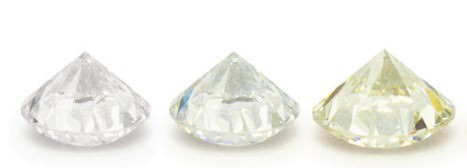
Diamond Colours left to right: D, H and N
One can gain an appreciation for the task of assigning colour grades by comparing samples of white paper. Collect a number of samples from different sources and examine them relative to one another. It is unlikely that any would appear to be exactly the same colour. Some will have a tint of grey, some a tint of blue, green, yellow, brown or other colours. The white papers present a colour range and it is possible to judge which is whitest, meaning displaying the least tint, the same as it is possible to judge which diamond is whitest.
Diamond is the only gemstone for which the absence of colour increases desirability and market value. The most common colour grading scale in use today is that of the GIA. It labels successive grades with the letters of the alphabet D through Z; stones beyond Z are graded as fancy colour and with these stones, the presence of colour is an asset. The grades DEF represent the colourless range, GHIJ near-colourless, KLM faint yellow colour, NOPQR very light yellow and S to Z the light yellow range. Subtle colour distinctions equate to very large differences in value. Colours designated to be equivalent to the first three grades in the GIA system (DEF) all appear colourless, the difference is the apparent transparency of the diamond. D colour diamonds are more limpid than E and F colour diamonds. Colour grades are commercially influenced and those at the top end of the scale are more narrowly defined in response to price premiums commanded by these higher colours.
Not everyone's experience of colour is the same. Fine colour discriminations like those required to perceive the difference between colour grades which are close together is not something every individual has the capability to do. On almost any test of colour vision people differ from one another and these forms of colour deficiency are non-dramatic and commonly go undetected; rarely is someone completely colour blind in the sense they cannot see colour at all. Most often it is just that their colour vision matches will not look satisfactory to someone with completely normal colour vision.
When it comes to diamond colour, some individuals make easier and truer fine discriminations than others. A word of caution to men here: colour deficiency in all forms is caused by defects of the chromosomes determining an individual's sex; females are ten times less likely to have colour deficiency than males. Colour is a heavy component of diamond value because of the degree to which it affects the beauty of the diamond. If you are challenged to see true colour, remember: it would be wise to assume that others will be able to see what you cannot.
CLARITY
Diamond clarity refers to the absence of inclusions or blemishes. Diamond forms deep within the earth at conditions of high temperature and high pressure, these conditions can result in a variety of internal characteristics called inclusions and external characteristics called blemishes.
A flawless diamond is an extreme rarity; most diamonds contain some gradable features. The presence of inclusions reduces light transmission through the diamond proportionately decreasing brilliance and beauty. Features that affect brilliance and beauty affect value; the closer a diamond comes to the ideal pure state, the flawless state, the higher its value.
Clarity grades express the presence of these characteristics in terms of scaled deviations from the ideal flawless state. Grades are assessed by a trained eye with corrected 10X magnification judging the appearance of a diamond in the face-up position. It is a two-step process: finding the characteristics and deciding how these characteristics affect clarity. The impact of inclusions on diamond clarity is judged according to five factors: number, size, position, brightness or relief, and nature or type. Clarity grading is not a matter of simply adding up all the inclusions and subtracting from flawless. Clarity grading is not a tally of faults. All five factors are more or less considered simultaneously and overall impression is what makes the grade.
The grading system commonly used in North America is that of the GIA. There are six categories, four of which are sub-divided for a total of 11 grades:
Flawless (FL) - free from all blemishes and inclusions.
Internally Flawless (IF) - free from all inclusions but possessing minor surface blemishes that can normally be removed with polishing and insignificant weight loss.
Very Very Slightly Included (VVS1 and VVS2) - containing minute inclusions that are very difficult for a trained grader to locate at 10X.
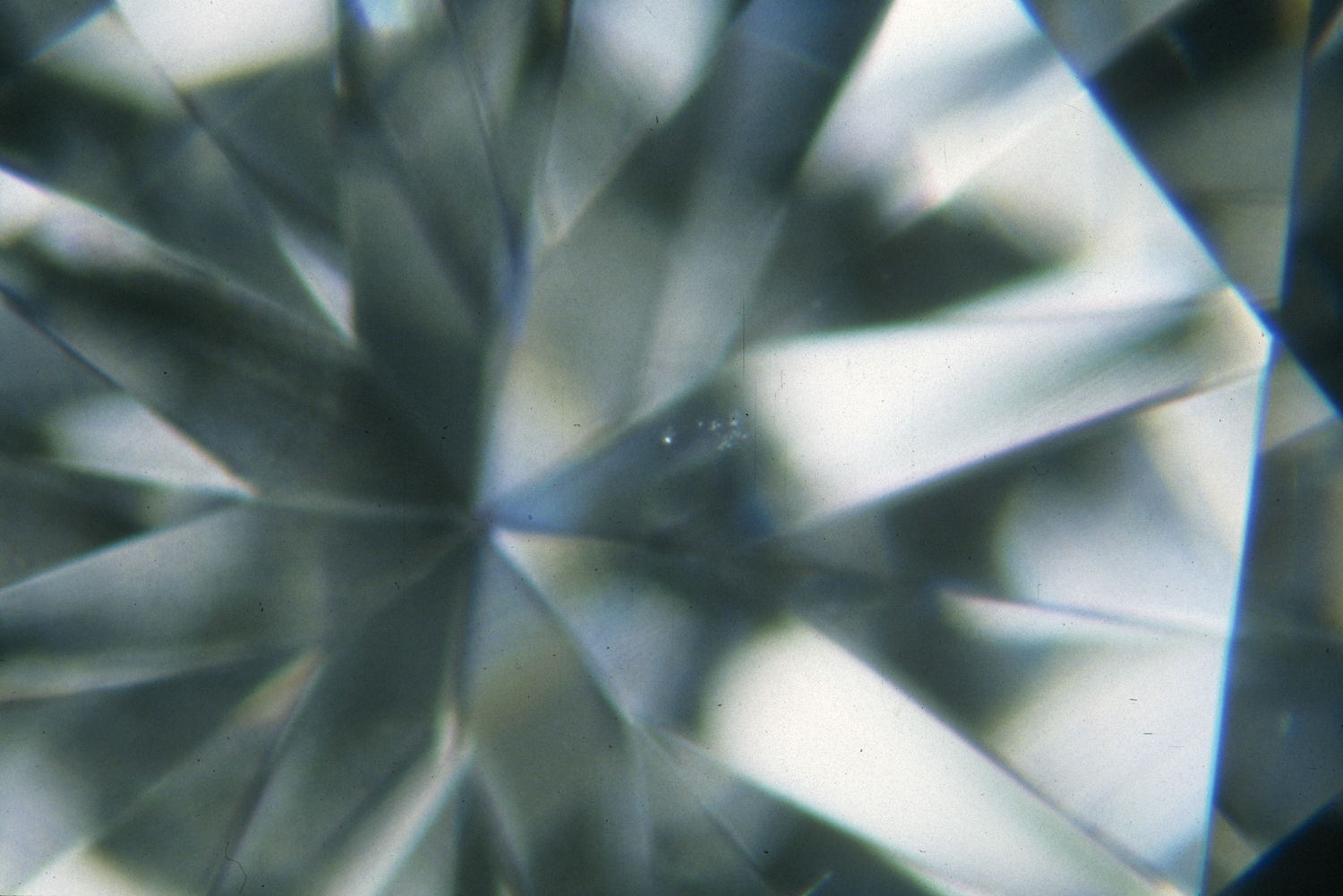
A tiny nest of pinpoints grade VVS2 at 10X, and are easily seen here at 63X.
Very Slightly Included (VS1 and VS2) - containing very small minor inclusions that are difficult to locate under 10X. VS2 inclusions are larger and slightly easier to locate.
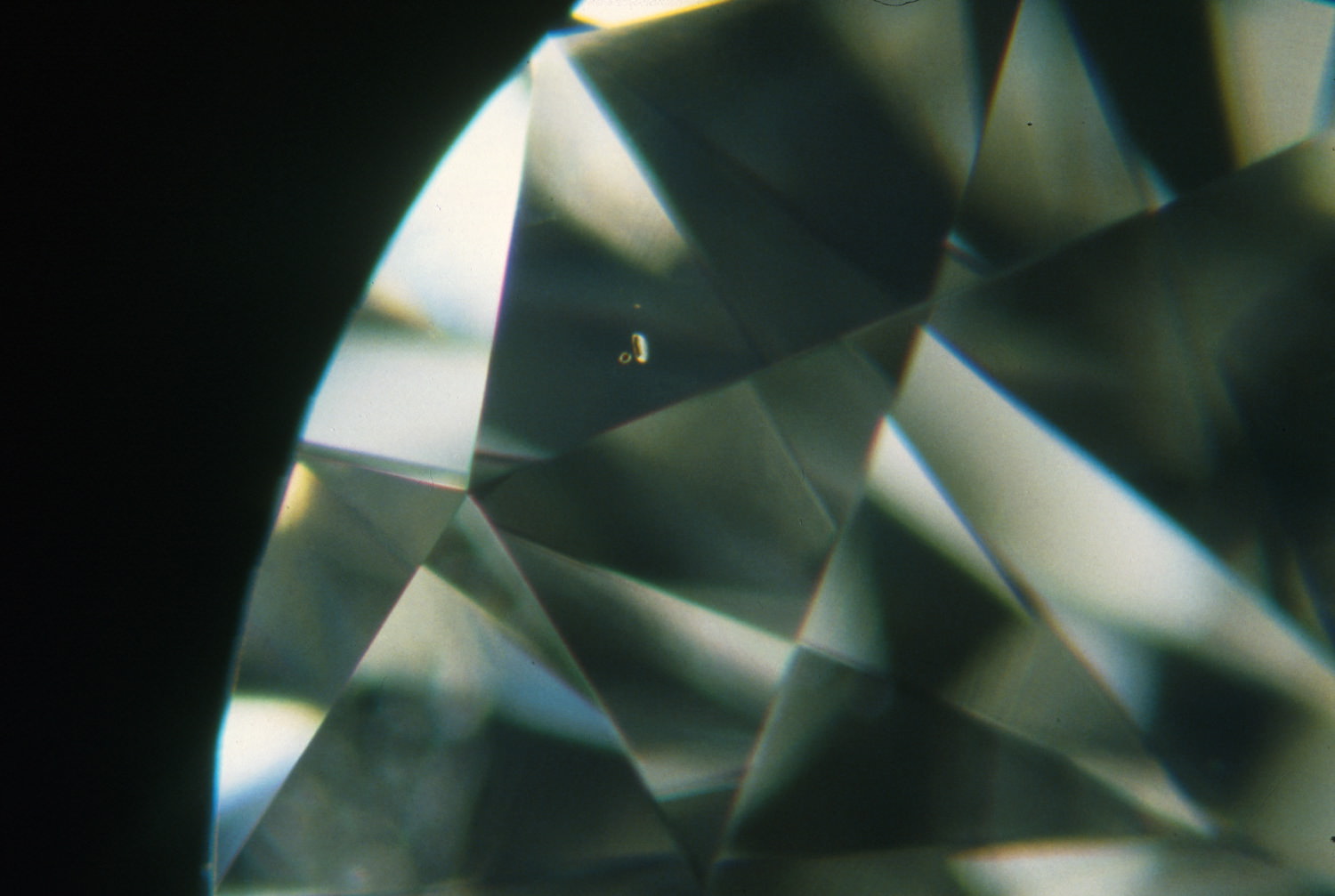
Two dark reddish-brown crystals - alone the smaller would grade VS1 but the larger is VS2 size and the grade maker.
Slightly Included (SI1 and SI2) - containing noticeable inclusions that are easy to locate at 10X. SI2 inclusions are typically larger and/or more centrally located than those of SI1.
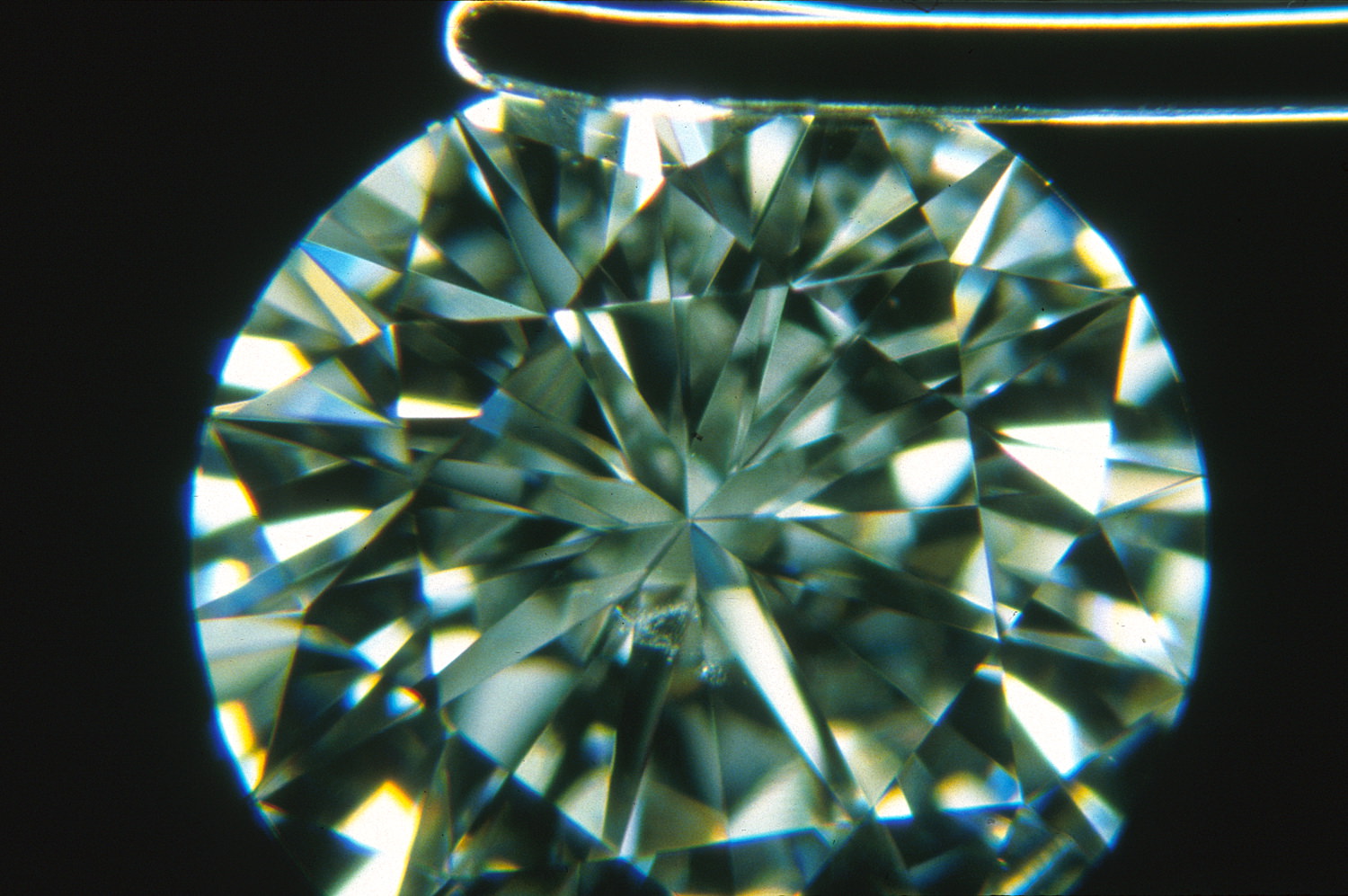
With a small cloud located in the table - although the cloud is small, the fact it is easily seen at 10X makes it SI1.
Included (I1, I2 and I3) - inclusions that range from immediately obvious to unsightly under 10X. With some exceptions, all these inclusions will be visible with the naked eye in the face-up. Inclusions across these grades range from somewhat affecting transparency, beauty and durability to severely compromising them. Diamonds grading as low as I3 are rare; these are just above industrial or rejection goods.
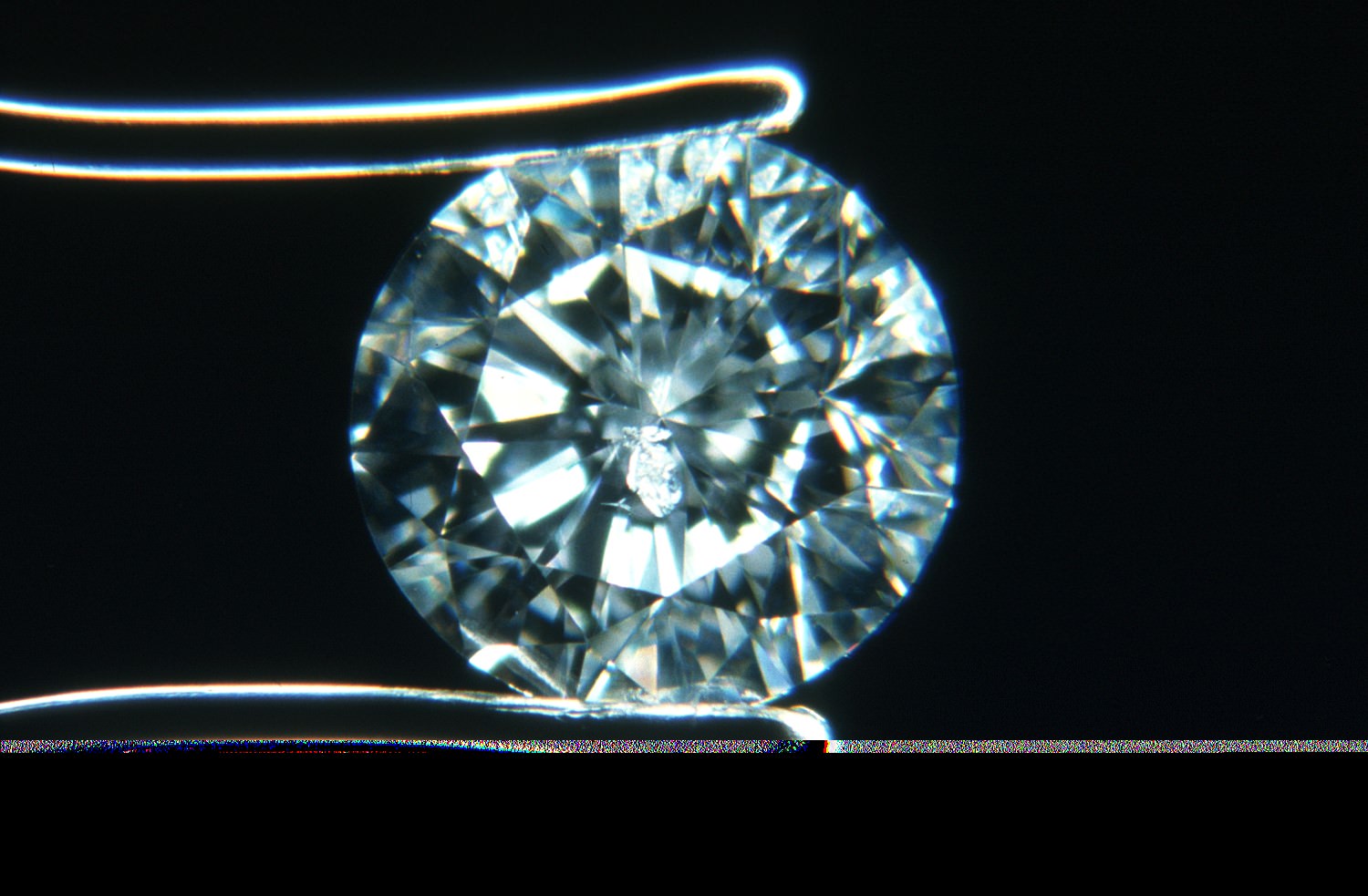
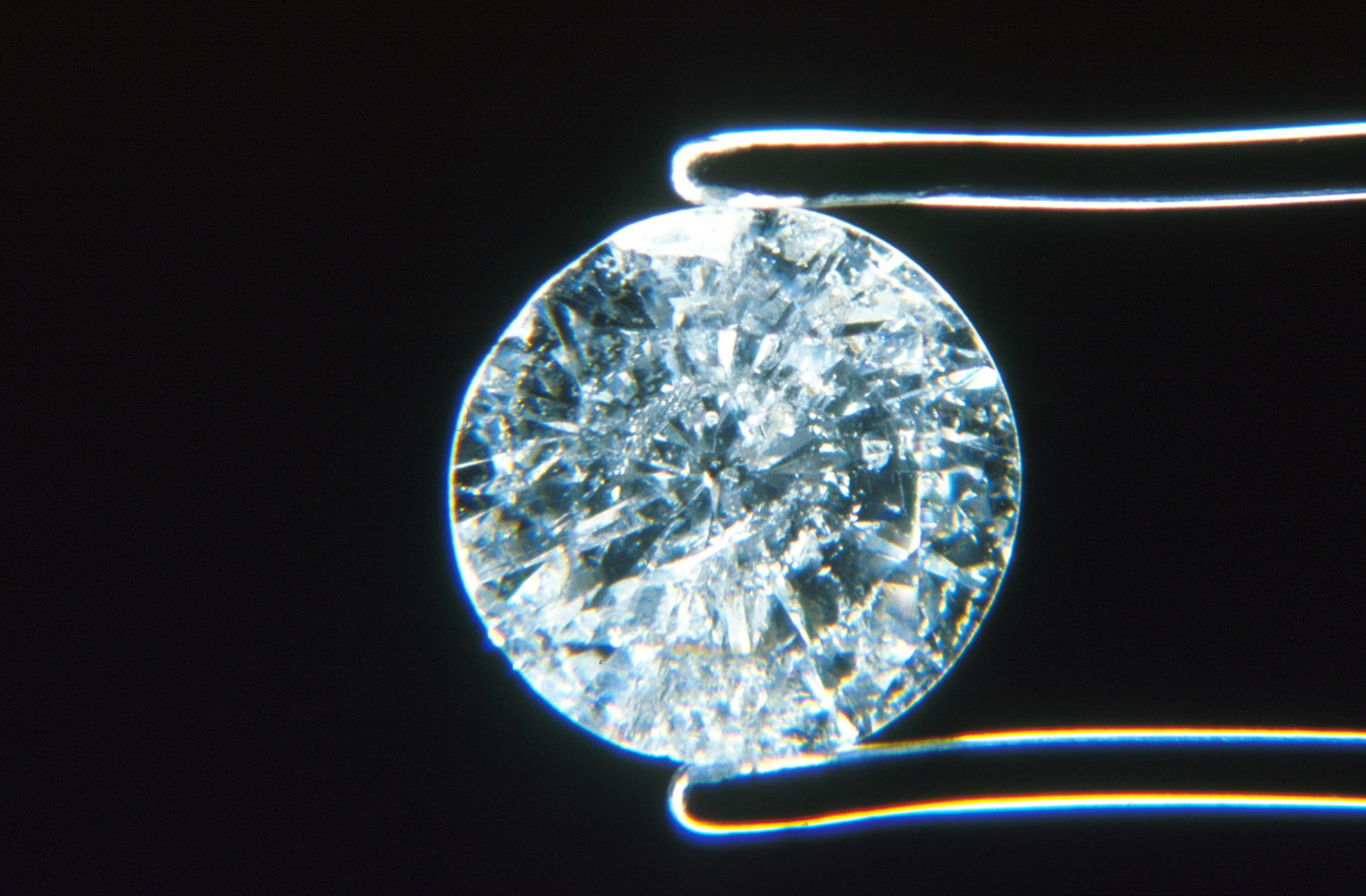
LEFT: The numerous SI1 size inclusions throughout the diamond reflect and refract to lower the grade to a high I1. RIGHT: Large and unsightly I3 inclusions fill this diamond. Very rarely is a stone of this grade submitted for grading.
Many inclusions and blemishes are too insignificant to be seen by anyone other than a trained diamond grader. To the naked eye, Flawless and SI2 can appear the same although there will be enormous differences in value, progressively decreasing through the grades. What grade is above where obvious inclusions mar diamond's beauty depends on the cutting style - emerald and Asscher cuts need to be cleaner because the large window on top of the stone makes inclusions more obvious. Beyond this, small incremental gains in clarity remain a prestige factor but are not visually obvious.
CUT
Grading cut is the act of visually assessing the effect of proportions and faceting quality on the overall beauty and brilliance of a diamond. In the diamond trade, the term cut can be used two ways. In the first sense, it refers to outline shape and style of cut - round brilliant, pear shape brilliant, emerald cut, etc. In the second sense, it refers to how well diamond proportions, symmetry and polish maximize beauty. A diamond is considered well cut if it has been cut within acceptable tolerances of an established norm.
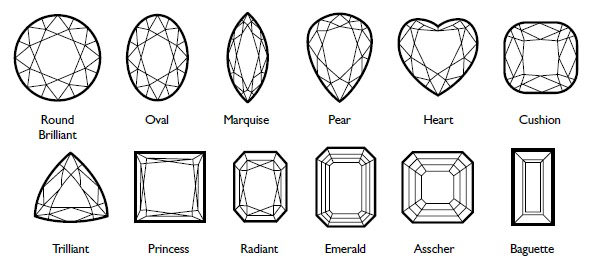
The magnificent appearance of a well cut diamond is attributed to the combination of three different light effects: (1) Brilliance is a mixture of two aspects, brightness and contrast, seen in a more or less face-up orientation. Brightness is an indication of how much of the light entering the top of the diamond is returned to the eye back out the top of the diamond. It is the sum effect of all internal reflections of light. Contrast refers to the light and dark reflections from within the diamond; (2) Fire is the vivid colours seen as a result of the diamond breaking up white light into its spectral colours and; (3) Scintillation refers to changes in the pattern of brilliance as a result of movement of the observer, the stone or the light source. Scintillation is judged by sparkle and pattern. Sparkle refers to the flashes of light resulting from movement and pattern refers to the degree to which these flashes balance in contrast and are evenly sized and distributed. Finely proportioned diamonds are often described as hard or sharp and an even contrast in pattern is what gives this look.
The laws of optics, in conjunction with diamond's optical properties, dictate that certain proportions are better at bringing out the beauty of a diamond than others.
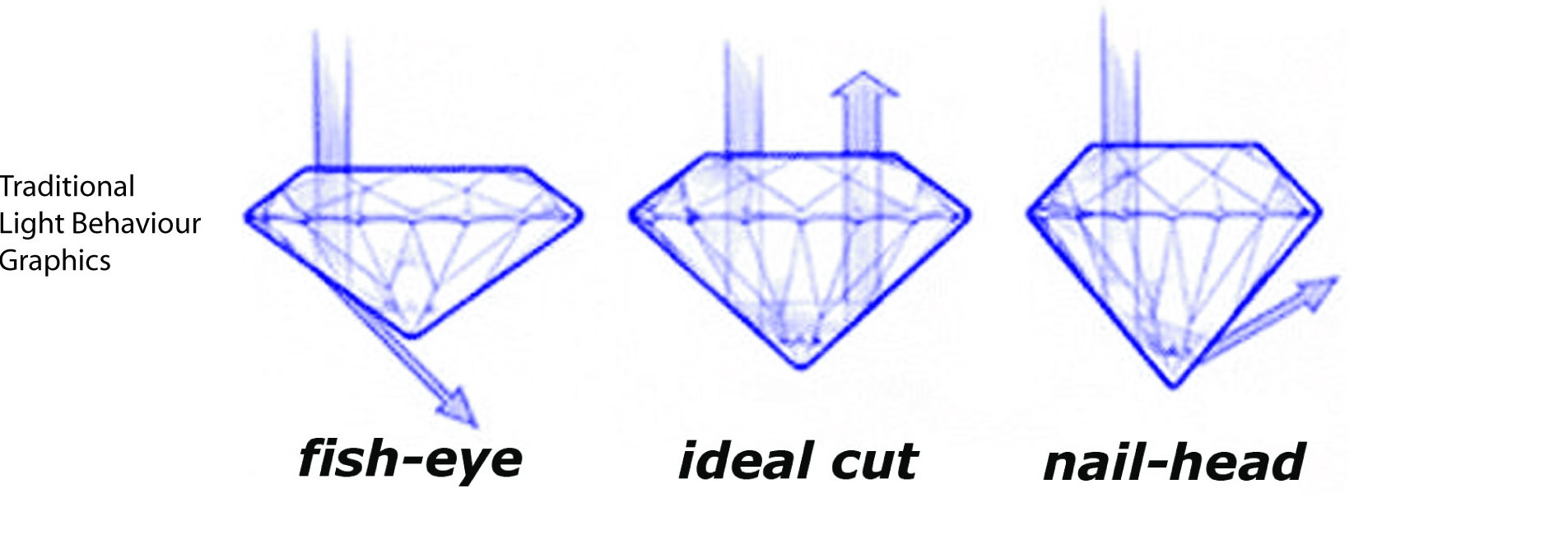
In the centre diamond, an ideal cut, the light which enters the top (crown) of the diamond is returned to exit through the top producing optimal light return and maximizing brilliance and beauty. To the left is a diamond which is too shallow in proportion causing light to leak out the bottom. Such diamonds are most often cut to maximize the diameter of the stone and appear larger, but at a cost to overall appeal. To the right is a diamond which is too deep in proportion causing light to escape from the side. These diamonds are normally cut to maximize weight retention, typically seen around the carat premiums to give the impression on paper of a more desirable weight. This too comes at a cost to the light performance of the diamond. Both of these actually reduce the diamond's beauty and its value.
Diamonds that have identical carat weight, clarity and colour can vary in value as much as 40%. This difference is attributable solely to variations in cut quality. A well-proportioned stone always commands a higher price. This requires a great deal of experience to assess and there is no world-wide singular opinion as to cut. Europeans typically prefer diamonds displaying greater colour flash and North Americans prefer greater white light return. It is not possible to maximize both in a single stone so fine cut remains hard to define, but poor cut is rather easily recognized.
Discover how to find the perfect diamond for you in the next section on Advanced Diamond Advice.

Loading...
